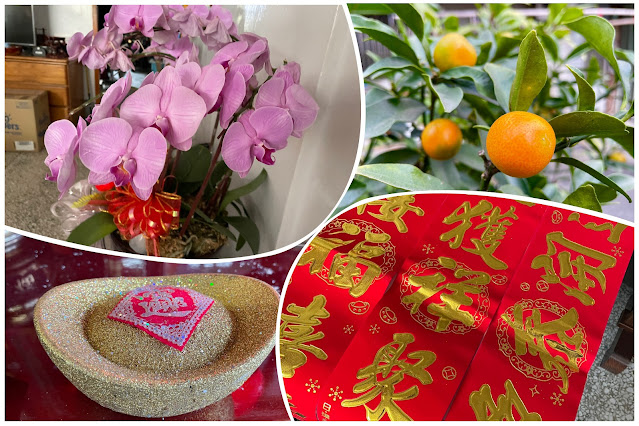Taiwanese people engage in various decorations for Chinese New Year, with most of them taking place on New Year's Eve. However, some individuals begin decorating their houses around 10 days prior to the event. The majority of these decorations incorporate the color red and auspicious imagery. In 2022, being the Year of the Tiger, tiger decorations will also be prominent.
Popular decorations during Lunar New Year
Red Lanterns - Used to Drive Off Bad Luck
Chinese lanterns, commonly seen during important festivals like the Spring Festival and the Mid-Autumn Festival, are hung on trees, office buildings, and house doors during Chinese New Year. Placing a red lantern in front of the door is believed to ward off bad luck.
Door Couplets - Conveying Best Wishes
New Year couplets (對聯; duìlián) are affixed to doors, expressing good wishes or meaningful statements. These couplets are usually written in black ink on red paper, with even numbers being preferred for their association with good luck and auspiciousness in Chinese culture. The couplets consist of two lines, often containing poetry related to the arrival of spring or expressing desires such as harmony and prosperity. Additionally, a four-character idiom of well wishes is commonly added to the crosspiece of the door frame.
Paper Cuttings - Symbolizing Luck and Happiness
Paper cutting is an art form in which designs are intricately cut out of paper, typically using red paper for the Spring Festival. The cutouts are then glued to a contrasting background or a transparent surface. Each animal or plant depicted in the paper cutting carries a different wish or symbol, such as peach for longevity, pomegranate for fertility, mandarin duck for love, pine tree for eternal youth, and peony for honor and wealth.
New Year Paintings - Representing New Year's Greetings
New Year paintings (年畫; niánhuà) are pasted on doors and walls during the New Year as decorative elements and symbols of New Year's greetings. These paintings often depict auspicious scenes, cultural motifs, or symbolic figures associated with good fortune and blessings.
Upside-Down Fu Characters - Inviting Luck
Inverted diamond-shaped calligraphy characters of the Chinese word 福 (fú), meaning good fortune, are affixed to or hung over doors. The characters are intentionally placed upside down, symbolizing the desire for good fortune to "pour out" onto the household.
Meanings of fruits and flowers during Chinese New Year
Kumquat Trees
Symbolizing Wealth and Good Luck. Kumquat trees, known as jinju shu (金桔樹; jīnjú shù) in Chinese, represent a wish for both wealth and good luck. The word jin (金) in Chinese means gold, while ju sounds similar to the word for good luck (吉; jí).
Pomelos
Signifying Good Luck and Family Unity. Pomelos, whether green or yellow, are considered significant fruits. They are used in cooking during the season leading up to the New Year and are believed to bring good luck to the household.
Apples
Representing Harmony and Peace. Apples, called píngguǒ (蘋果) in Chinese, sound similar to the word 平 (píng), meaning peace or tranquility. Green apples symbolize money, while red apples represent prosperity and abundance.
Watermelons
Symbolizing Wealth and Prosperity. Watermelons are associated with wealth and prosperity due to the abundance of seeds they contain.
Grapes
Grapes are symbolic of wealth, fortune, fertility, and prosperity.
Decorating homes with blooming flowers symbolizes the anticipation of a prosperous new year. Traditional choices include branches of plum blossoms, orchids, peonies, and peach blossoms.
Pussy Willows
Signifying Growth and Prosperity: Pussy willows are considered a symbol of growth and prosperity, representing the arrival of good fortune.
Lucky Bamboo
Lucky bamboo is a Chinese symbol of strength and resilience. It is often shaped into various forms, decorated with red ribbons and lucky ornaments.
Orchids
Symbolizing Fertility and Abundance: Orchids are delicate, elegant flowers associated with feminine beauty, innocence, affection, and charm. They are also considered symbolic of fertility and abundance.
Peach Blossoms
Signifying Prosperity and Growth: Peach blossoms symbolize romance, prosperity, and growth. They are particularly favored by single young people seeking love.
Plum Blossoms
Representing Endurance and Courage: Plum blossoms, with their vibrant pink color, symbolize endurance and courage. They are associated with perseverance and reliability, traits essential for achieving success in life. The plum, along with orchid (purity), bamboo (uprightness), and chrysanthemum (humility), is considered one of the "Four Nobles" in Chinese culture.
Peonies
Symbolizing Richness and Peace: Peonies are beautiful flowers associated with richness, peace, and prosperity. They are often admired for their elegance and charm.
Narcissus or Water Fairy Flowers
Representing Good Fortune and Prosperity: Narcissus or Water Fairy Flowers are considered symbols of good fortune and prosperity. These delicate flowers have a unique appearance and are highly valued during the Lunar New Year.
Flamingo Lily
Signifying Prosperity: Red or pink flamingo lilies are commonly used decorations during Chinese New Year, symbolizing prosperity. With blossoms shaped like little hearts, these flowers are also popular for Valentine's Day.







0 komentarze:
Post a Comment